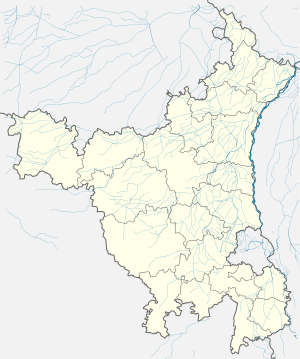Jognakhera
Jognakhera is a site belonging to late Harappan phase of Indus Valley Civilisation. Jogankhera is located in Kurukshetra District, Haryana, India.[1]
Jognakhera | |
|---|---|
Archeological site | |
 Jognakhera  Jognakhera | |
| Coordinates: 29°58′17″N 76°53′14″E | |
| Country | India |
| Province | Haryana |
| Time zone | UTC+5.30 (Indian Standard Time) |
Period
.png)

The find from this site belong to the mature Harappan phase as well as later-era PGW phase (Vedic period).[2] The Painted Grey Ware culture (PGW) probably corresponds to the middle and late Vedic period, i.e., the Kuru-Panchala kingdom, the first large state in South Asia after the decline of the Indus Valley Civilization (IVC).[3][4] Painted Grey Ware culture (PGW) chiefdoms in the region were succeeded by Northern Black Polished Ware (NBPW) from c. 700-500 BCE, associated with the rise of the great mahajanapada states (mahajanapada states Kuru, Panchala, Matsya, Surasena and Vatsa)[2] and later of the Magadha Empire.[3][4] Towards the end of the late Vedic period, many of the PGW settlements grew into the large towns and cities of the Northern Black Polished Ware (NBPW) period.[5] B.B. Lal confirms that Mahabharata is associated with PGW sites and gives a date to c. 900 BCE for the War recounted in the Mahabharata.[6]
Saraswati valley has the earlier phase of the PGW culture, such as excavation at Hat (Hathira) in Kurukshetra. Hathira was protected by a V shaped moat.[2] Similar moats were found Jognakhera and Kunal on the Saraswati river. The presence of moat shows these were chiefdom-based cultures. These cultures reach a peak in Ganga-Yamuna Doab before the rise of Mahajanapadas in the Northern Black Polished Ware period.[2]
Excavation
Jognakhera was excavated during 2009, although local people are not aware of the importance of this ancient site.[7] Pot shreds were also recovered from this site.[7]
Copper smelting
Jognakhera was a copper smelting site where copper smelting furnaces with copper slag were recovered.[7] The furnaces excavated from this site looked like huge saucers. [7]
Damage to site
Floods created out of breach to Sutlej Yamuna link canal during July 2010 caused damage to this archeological site.[7]
See also
- Indus Valley Civilization* List of Indus Valley Civilization sites
- List of inventions and discoveries of the Indus Valley Civilization
- Hydraulic engineering of the Indus Valley Civilization
- Kunal, Haryana (copper smelting)
References
- Ghosh, Amalananda (Ed.) (1990). An Encyclopaedia of Indian archaeology. Leiden: E.J. Brill. p. 187. ISBN 9789004092648.CS1 maint: extra text: authors list (link)
- Suraj Bhan, Ancient Asia Journal.
- Geoffrey Samuel, (2010) The Origins of Yoga and Tantra: Indic Religions to the Thirteenth Century, Cambridge University Press, pp. 45–51
- Michael Witzel (1989), Tracing the Vedic dialects in Dialectes dans les litteratures Indo-Aryennes ed. Caillat, Paris, 97–265.
- "Archived copy" (PDF). Archived from the original (PDF) on 1 January 2014. Retrieved 5 December 2017.CS1 maint: archived copy as title (link)
- http://es.slideshare.net/sfih108/mahabharata-historicity-prof-b-b-lal
- Sabharwal, Vijay (11 July 2010). "Indus Valley site ravaged by floods". The Times Of India.